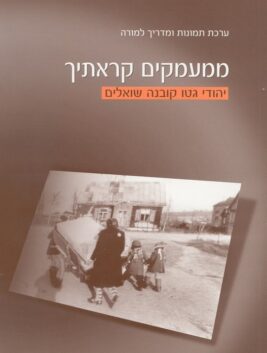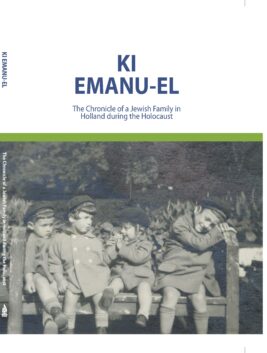Ganzach Kiddush Hashem emphasizes experiential learning combining historical knowledge with educational values that empower the students. For this purpose, Ganzach, with the help of pedagogical and history experts, has created study kits, based on archival research and items in our collections. The study kits include educational films produced by Ganzach, historical information, as well as study booklets and activities. These study kits are an effective teaching method and have received enthusiastic reviews from both teachers and students alike. The kits allow visitors as well as people searching the internet, to access our archival sources and use them for educational purposes.
To view the Hebrew kits, please click here. Thus far, the study kits available in English are:
Out of the Depths, I Cry Out: The Jews of the Kovno Ghetto Seek Guidance
The program “Out of the Depths, I Cry Out,” deals with the Kovno Ghetto, one of the few ghettos established in Lithuania. The stories of the Jews in the ghettos in Eastern Europe have already been reflected upon in research and in various study units, but so far only a few have dealt with this ghetto in which Jewish life was rich and unique, and whose stories deserve to be a central part of the curriculum about the ghettos. The special historical sources that have survived from these ghettos, questions and answers on Halacha (Jewish law), photographs, and many Jewish writings, make it possible to examine life in the ghetto from a Jewish religious point of view, and this is the purpose of this program.
The study unit conveys to students life in the Kovno Ghetto: the process of its establishment and the stages of its existence, the suffering and pain of the Jews, and the Jewish stance in the ghetto. The point of departure from the average study of ghettos and the focus of the discussion is through the lens of the camera and on halachic questions that were asked in the Kovno Ghetto during all the years of its existence.
The unit consists of 2 parts:
- A set of 18 posters. The posters contain pictures of ghetto life and halachic questions that were asked in Kovno. Each poster presents a certain topic from the life of the ghetto and its sufferings, and the picture and the question form a starting point for a conversation (picture-dialogue). Placing the picture and the question on the same poster expresses the spiritual-moral struggle of the ghetto and its leaders in light of the harsh reality.
2. An instruction booklet that gives didactic suggestions and enrichment material for conversation and discussion.
The booklet includes:
- Historical introductory information on Kovno, its history, and many events that took place in the city. In the introduction, there is also a timeline and a map, which are tools for the teacher and help guide the discussion process that accompanies the entire unit.
- The units are based on the posters, with a didactic suggestion on each of them: enrichment material on the posters from various historical sources. There is much material and it is varied, allowing for the teacher to choose the appropriate sections for the students.
The kit includes
- Disc to see the 18 posters
- Instruction booklet
- Enrichment materials
Out of the Depths, I Cry Out: The Jews of the Kovno Ghetto Seek Guidance
The program “Out of the Depths, I Cry Out,” deals with the Kovno Ghetto, one of the few ghettos established in Lithuania. The stories of the Jews in the ghettos in Eastern Europe have already been reflected upon in research and in various study units, but so far only a few have dealt with this ghetto in which Jewish life was rich and unique, and whose stories deserve to be a central part of the curriculum about the ghettos. The special historical sources that have survived from these ghettos, questions and answers on Halacha (Jewish law), photographs, and many Jewish writings, make it possible to examine life in the ghetto from a Jewish religious point of view, and this is the purpose of this program.
The study unit conveys to students life in the Kovno Ghetto: the process of its establishment and the stages of its existence, the suffering and pain of the Jews, and the Jewish stance in the ghetto. The point of departure from the average study of ghettos and the focus of the discussion is through the lens of the camera and on halachic questions that were asked in the Kovno Ghetto during all the years of its existence.
The unit consists of 2 parts:
- A set of 18 posters. The posters contain pictures of ghetto life and halachic questions that were asked in Kovno. Each poster presents a certain topic from the life of the ghetto and its sufferings, and the picture and the question form a starting point for a conversation (picture-dialogue). Placing the picture and the question on the same poster expresses the spiritual-moral struggle of the ghetto and its leaders in light of the harsh reality.
2. An instruction booklet that gives didactic suggestions and enrichment material for conversation and discussion.
The booklet includes:
- Historical introductory information on Kovno, its history, and many events that took place in the city. In the introduction, there is also a timeline and a map, which are tools for the teacher and help guide the discussion process that accompanies the entire unit.
- The units are based on the posters, with a didactic suggestion on each of them: enrichment material on the posters from various historical sources. There is much material and it is varied, allowing for the teacher to choose the appropriate sections for the students.

Ki Emanu-El (For G-d is With Us): The Chronicle of a Jewish Family in Holland During the Holocaust
Prewar Europe was full of vibrant Jewish communities that had existed for generations. Each of these communities was home to communal institutions, including growing educational institutions. Within each community, different streams of Judaism developed over the years and affected its character. No two communities were identical. The nature of the community depended not only on the makeup of its members, but on the various religious streams that reached it, on the local Jewish leadership, and on the extent to which the Jews were integrated in the surrounding gentile society. While community life affected the individual, the individual both reflected and influenced the character of the local community.
The story of the Holocaust, then, is the story of each and every community and each and every family; the family being the link between the individual and the community, the foundation stone on which the existence of the Jewish nation rests. The unique aspect of this study unit is that it focuses on one community out of many, and on the story of one family that experienced all the horrors, survived them, and rebuilt itself.
The community is that of Dutch Jewry, and in its midst was a group of immigrants who had arrived in Holland from Germany and Austria. They carried with them a way of life that was firmly anchored in the principles of “Torah im derech eretz” (Torah with the way of the land). They were destined to share the same fate as that of native Dutch Jews, though initially it did not seem that it would be so.
The story of the Emanuel family was recorded by Yonah Emanuel in his book Dignity to Survive, and has been preserved in the letters and writings of other members of the family. These all served as the basis for this unit.
Through the medium of the story of one family, the student will be able to gain insight into the experiences of the Jews of Holland. The connection to one family and its members will bring the topic close to the student’s heart, allowing him/her to understand the hardships of the time, the enormity of the catastrophe, and the greatness of the Jews’ religious steadfastness.
We are grateful to Mrs. Emanuel and the members of the family for their cooperation in making their memories available to the next generation of students.
The structure of the unit and didactical suggestions
This study unit is structured chronologically, relating the Emanuel Family’s story at a few stages in time. At each of these stages, information is given about the socio-political situation, the members of the family, and the Jewish values that served the family as an anchor at all times. The stages are:
- Prewar – family life
- The effect of Kristallnacht in Germany on the Jews in Holland
- The occupation – life in Holland under the Nazi regime
- The transportations from Holland to concentration camps; finding places to hide
- Westerbork transit camp
- Liberation and the rebuilding of the family
- In Israel
The kit includes
Ki Emanu-El (For G-d is With Us): The Chronicle of a Jewish Family in Holland During the Holocaust
Prewar Europe was full of vibrant Jewish communities that had existed for generations. Each of these communities was home to communal institutions, including growing educational institutions. Within each community, different streams of Judaism developed over the years and affected its character. No two communities were identical. The nature of the community depended not only on the makeup of its members, but on the various religious streams that reached it, on the local Jewish leadership, and on the extent to which the Jews were integrated in the surrounding gentile society. While community life affected the individual, the individual both reflected and influenced the character of the local community.
The story of the Holocaust, then, is the story of each and every community and each and every family; the family being the link between the individual and the community, the foundation stone on which the existence of the Jewish nation rests. The unique aspect of this study unit is that it focuses on one community out of many, and on the story of one family that experienced all the horrors, survived them, and rebuilt itself.
The community is that of Dutch Jewry, and in its midst was a group of immigrants who had arrived in Holland from Germany and Austria. They carried with them a way of life that was firmly anchored in the principles of “Torah im derech eretz” (Torah with the way of the land). They were destined to share the same fate as that of native Dutch Jews, though initially it did not seem that it would be so.
The story of the Emanuel family was recorded by Yonah Emanuel in his book Dignity to Survive, and has been preserved in the letters and writings of other members of the family. These all served as the basis for this unit.
Through the medium of the story of one family, the student will be able to gain insight into the experiences of the Jews of Holland. The connection to one family and its members will bring the topic close to the student’s heart, allowing him/her to understand the hardships of the time, the enormity of the catastrophe, and the greatness of the Jews’ religious steadfastness.
We are grateful to Mrs. Emanuel and the members of the family for their cooperation in making their memories available to the next generation of students.
The structure of the unit and didactical suggestions
This study unit is structured chronologically, relating the Emanuel Family’s story at a few stages in time. At each of these stages, information is given about the socio-political situation, the members of the family, and the Jewish values that served the family as an anchor at all times. The stages are:
- Prewar – family life
- The effect of Kristallnacht in Germany on the Jews in Holland
- The occupation – life in Holland under the Nazi regime
- The transportations from Holland to concentration camps; finding places to hide
- Westerbork transit camp
- Liberation and the rebuilding of the family
- In Israel













